|
Moravian Instruments filter wheels are always computer controlled
like cameras themselves, so they can be integrated into complete
imaging setups.
There are three classes of Moravian Instruments filter
wheels:
Internal filter wheels (IFW) External filter wheels (EFW) Standalone filter wheels (SFW)
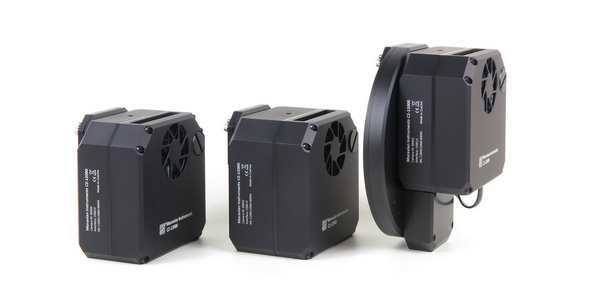
C2 Camera without filter wheel (left), with Internal filter
wheel (middle) and with attached External filter wheel
(right) There are fundamental differences among these three filter
wheel types:
Internal and external filter wheels are
always controlled and powered by the camera, there is no power or
USB plug. Also, these filter wheels do not need own drivers;
commands, controlling their operation, are passed through the camera
driver. Standalone filter wheels on the other side contain
own electronics and thus require standalone power line and
communication line to the host PC. They also need own drivers,
beginning with USB system driver, user space application driver
etc.
Cameras with Internal Filter Wheels
The C2 and C3 camera lines, combining asymmetrical camera head
design and relatively small sensors, can incorporate filter wheels
directly into the front camera shell, which is then manufactured
slightly thicker.
Internal filter wheels bring several
advantages:
Camera head is only slightly thicker and heavier,
compared to camera without filter wheel, head width and height
remain unchanged. Camera with IFW make up a single device without obvious
mechanical or electrical connections. There is more space for filters inside the camera shell
compared to External filter wheel shell — up to 10 mm space is
available, compared to just 6 mm in
the EFW.
But integrating the filter wheel into camera also
brings disadvantages:
IFW dimension and thus also number of filter positions
are limited by the camera head front cross-section. IFW cannot be integrated into cameras incorporating large
sensors (C4 and C5 lines), despite the asymmetrical design of
the camera head. Changing filters require opening the camera head,
exposing mechanical shutter and camera electronics, which
require great care not to damage these components. Also, closing
the camera is more demanding as it is necessary to properly
arrange internal cabling etc.
So, in general, IFW is suitable for applications using
relatively small number of filters, which are exchanged rather
exceptionally. For instance, photometric camera operating with
Johnson-Cousin UBVRI filters only is a good example.
Cameras with External filter wheels
All Moravian Instruments cameras are equipped with electronics,
capable to drive the filter wheel. Also, the camera firmware and
command set include instructions to control the wheel.
Cameras without IFW are manufactured with thinner front shell
to save weight and to shrink the camera back focal distance (BFD),
which means the internal wheel cannot be added later. Filter wheel
controlling electronics remains unused in such case.
So, cameras without IFW are equipped with an external connector
containing all signals necessary to control a filter wheel. If an
External filter wheel is mechanically attached to the camera head,
it is possible to connect it to the camera head using single 8-pin
wire to provide power and control signals to the wheel.
Tip: Because the External filter wheels use the power and
control provided by the camera, EFWs do not need any additional
power and control lines. From the software point of view, there is no difference between
IFW and EFW. Software only sees the filter wheel controlled by the
camera, regardless if the wheel is inside camera shell or in a
separate shell, bolted to the camera head.
Upozornění: Using single electronics to control either IFW or EFW
means, that a camera cannot use both filter wheels at once.
Decision which filter wheel is to be used must be made upon camera
purchase, as the differences between both variants are substantial
(different front and back shells, different digital electronics).
While modifying the IFW variant to the EFW one and vice versa is
in principle possible, it is economically not viable, because of
too many parts must be replaced. 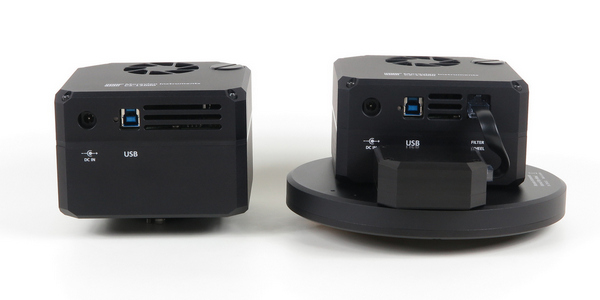
C2 camera with Internal filter wheel (left) and with
External filter wheel attached (right) External filter wheels bring many advantages:
EFWs offer wide range of filter sizes and filter slot
positions. As EFWs can incorporate very large filters (up to
65 × 65 mm), they are offered also for cameras with
large and very large sensors (C4 and C5 series). EFWs are compatible with both asymmetrical cameras (C2,
C3, C4, and C5A) and corresponding symmetrical models (C1+,
C1×, C5A). Opening the EFW shell and exchanging filters is easier,
as there are no mechanical of electronics devices inside the
shell but the wheel motor drive.
Using of an External filter wheel also brings some
negatives:
Camera with EFW is bulkier and heavier compared to the
IFW variant. While the IFW is accessible from the back side when the
camera front shell is removed and filter wheel itself need not
to be removed from the shell, EFWs are opened from the front
side and filter wheel must be removed from the shell to be able
to install or replace filters. Only 6 mm space is available
for filters inside the EFW shell, compared to 10 mm space in the IFW.
Cameras with Standalone filter wheels
The external filter wheel diameter has construction limits, it
is not possible to simply increase both EFW shell and filter wheel
itself. The diameter and weight would be so big, that usage of
such wheels would not be practical.
Natural solution of this problem is placing of two smaller
filter wheels beside each other. The total number of filter
positions is lower than the sum of positions in both wheels from
obvious reason: one position in each wheel must remain empty
(clear) and it is set as an actual position when a filter from the
other wheel is to be used not to interfere with it. So, if for
instance two filter wheels with five positions each are used, we
denote such wheel as „8+Clear“ positions. This means four
positions in both wheels may be used for any filter, which makes 8
total filter positions. When both filter wheels are set to index 0
(the clear position), one additional clear position is added to
the total number of filter positions.
The filter wheel controlling electronics, incorporated into
Moravian Instruments cameras, cannot control two independent
filter wheels simultaneously. So, the new line of Moravian
Instruments filter wheels is equipped with own control electronics
and naturally require own control and power lines, fully
independent on the camera. This is why the new line is called
Standalone filter wheels (SFW).
Standalone Filter Wheel attached to the C5S
camera Tip: SFW is the first and only line of Moravian filter wheels,
capable to operate without Moravian camera and thus usable also
with other brand cameras or without a camera at all. Using of SFWs brings also changes to the driver structure.
While IFWs and EFWs are controlled through a camera, SFWs need own
driver stack. This means a Windows or Linux system USB driver must
be installed, as well as a new user space libraries (e.g. ASCOM in
Windows, INDI or driver libraries in Linux) etc.
Also, client software may handle the SFW differently. For
instance, SIPS differentiates between filter wheel drivers handled
by camera and fully independent filter wheel drivers:
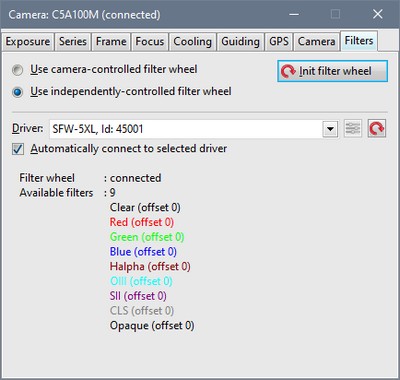
The Filters tab of the SIPS Imaging Camera tool allows
selection between camera-controlled and standalone filter
wheels Fixing filters into filter wheel
There are two standards of filter mounting mechanism
used in astronomical instruments:
Filters mounted in threaded cells are intended
to be screwed into a threaded socket in the filter
wheel. Unmounted filters (either glass-only, or with
metal rings around the glass) have to be fixed into the wheel
socket using screws.
Filter in threaded cells
Only two diameters of filter cells standardized
over years, in fact copying the standard diameter of
telescope focusers and eyepiece mounting barrels (many new
filter diameters and formats, introduced with ever
increasing size of astronomical camera sensors, remained
unmounted):
1,25” diameter cells. 2” diameter cells.
Filters in 1.25-inch diameter cells
While the outer diameter of these cells is well
defined (1,25” or
31,75 mm), attempts to standardize the
thread, used on the 1,25” cells,
failed:
The thread diameter converged to
28,5 mm
and all filter manufacturers are at or very close to
this diameter. Thread pitch on the other side quite varies
among various companies:
Some European companies standardized on
0,5 mm
pitch. Some American companies use 40 TPI, which leads to
0,635 mm pitch. Some companies manufacture the cell thread
with pitch somewhere between these two
extremes.
Luckily, the thread length is typically very small
(just 2 mm on Moravian filter
wheels) and thus the thread pitch differences play only
small role.
Moravian Instruments filter wheels are designed to be
as compatible with various standards as possible, using
M28.5 × 0,55 thread.
Major filter brands, both European and American, can be
used with them.
Filters in 2-inch diameter cells
Luckily, the M48 × 0,75 thread,
used on 2” cells, is the same regardless of the filter
manufacturer.
Unmounted filters
Unmounted filters must be fixed in filter wheel socket
using screws. Filters are often just a piece of glass, which
could be easily damaged if it is tightened only by metallic
screw head. Moravian Instruments filter wheels are always
accompanied with a set of plastic washers to be used between
the filter itself and the fixing screw.
Moravian Instruments filter wheels use socket
allowing to fix filters only 1 mm thick. But on the other side, much
thicker filters must also remain compatible with the filter
wheel. This is why different types of screws and washer
orientation is recommended according to the thickness of the
used filters:
M3 × 4 screw with
cylinder head and a plastic washer oriented „upside
down“ is recommended for 1 mm thick filters. M3 × 4 screw with
cylinder head and a normally oriented plastic washer is
recommended for 2 mm thick
filters. M3 × 8 screw with
countersunk head and a normally oriented plastic washer is
recommended for 3 mm and
thicker filters.
Filter Wheel Vignetting
Filter input pupil may block part of the light cone, created by
the used optics (telescope or photographic lens). Shielding
typically occurs further from the optical axis, which results into
darkening of the image closer to the sensor edges or corners. Such
darkening is called vignetting.
Vignetting depends on four dimensions:
The used optical system f/ratio (focal length / input
diameter), which defines the angle of the light input
cone. Sensor size (diagonal for round filters, longer edge for
square filters). Filter diameter or edge length. Filter or filter wheel distance from the focal
plane.
Specific limiting f/ratios for each camera (sensor), filter
dimension, and filter wheel class (distance of the input pupil
from the sensor) are stated in the respective filter wheel class
description.
Internal Filter Wheels
Internal filter wheels are available for C2 and C3 cameras
only, as the C4 and C5 camera require 50 × 50 mm or even
65 × 65 mm square filters, which are too big to fit
into relatively small internal filter wheel.
C2 camera model with Internal filter wheel
accepts two sizes of filters:
5 positions for unmounted D31 mm filters or filters in
1,25” threaded cells. 6 positions for unmounted D26 mm (or 1”) filters.
C3 camera model with Internal filter wheel
accepts two sizes of filters:
Filter space
The space available for filters is the same for
both C2 and C3 cameras, but it differs depending on the
filter wheel type. The 3 mm thickness of the filter wheels
designed for both unmounted filter and filter in threaded
cells is divided to 2 mm of thread and 1 mm of a deepening
for unmounted filter. The same 3 mm thickness of the filter
wheels intended only for unmounted filters offer 2 mm
deepening. This means the unmounted filters can be up to 1
mm thicker in this filter wheel compared to filter wheel
also compatible with threaded cells.
The barrel portion of the filter threaded cells, used
in the Internal wheel, can be up to 8 mm thick. The thread can be up to
3 mm long. So, the total
thickness of the cell can be up to 11 mm. Unmounted filters, but fixed in the wheel designed
also for threaded filter cells, can occupy up to 8 mm space. Note such space includes not
only the filter itself, but also the fixing screw head and
washer. As the head and washer thickness typically slightly
exceed 2 mm, it is safe to use
up to 5 mm thick unmounted
filters. Filter wheels designed for unmounted filters only
(either D26 mm/1” or
D36 mm filters) can accommodate
up to 1 mm thicker
filters.
Installing or exchanging filters
It is necessary to open the camera head to change filters
or the whole filter wheel.
Tip: There are numbers (filter positions) of individual
filter slots engraved in the wheel. Opening the C2 camera head
To open the head, unscrew the six bolts holding camera
head together.
The blade shutter rotates 180° between individual
snapshots. Camera cover could be opened only when the
shutter is fully closed (covers the sensor). If for
instance the camera is unplugged from power adapter while
exposing, the shutter remains open. Camera cannot be
opened in such case.
Upozornění: Shutter can be damaged while removing the
camera cover if not in proper position. 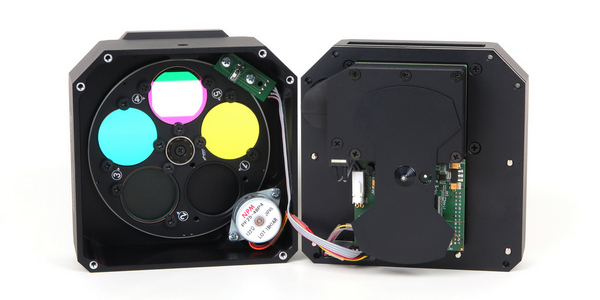
Filters in the Internal filter wheels can be
exchanged after removing of the camera front
cover After removing the screws carefully turn the camera
head by the telescope adapter upward. Gently pull the
front part of the case. Notice there are two cables,
connecting the filter wheel motor and the filter position
optical bar, plugged into the electronics board. It is not
necessary to unplug these cables to change filters, but if
you unplug them, take care to connect them again in the
proper orientation!
Tip: Moravian Instruments filter wheels are always
designed so the aperture manufactured in the wheel, not
the inserted filter, faces the incoming light cone. So,
the complex shapes like unmounted filter edges, holding
screws, etc., possibly causing reflections, are always
hidden from the incoming light. The geometry of the
IFW allows to insert or replace filters without removing
the filter wheel front the camera front shell. Opening the C3 camera head
To open the head, unscrew the eight bolts holding
camera head together.
After removing the screws carefully turn the camera
head by the telescope adapter upward. Gently pull the
front part of the case. Notice there are two cables,
connecting the filter wheel motor and the filter position
optical bar, plugged into the electronics board. It is not
necessary to unplug these cables to change filters, but if
you unplug them, take care to connect them again in the
proper orientation!
Changing the Whole Filter Wheel
The whole filter wheel can be changed at once. It is
necessary to remove the front part of the camera case the
same way as in the case of changing filters. The filter
wheel can be removed when you unscrew the bolt on the
center of the front part of camera case. Take care not to
damage the horseshoe-shaped optical bar when replacing the
filter wheel.
Internal filter wheel vignetting
The Internal filter wheel input pupil is 24 mm from the sensor. This is valid for both
C2 and C3 cameras, despite the illustration below shows the C3
camera only.
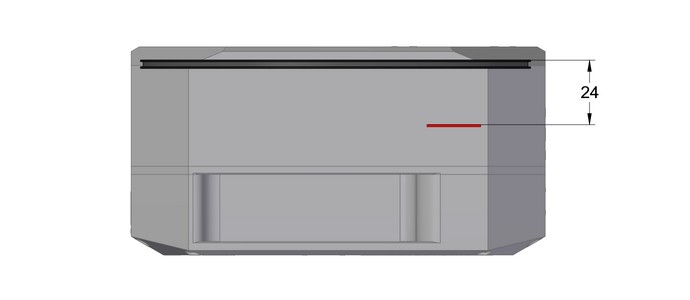
Internal filter wheel input pupil distance to
sensor C2 cameras with Internal filter wheel
Limiting telescope f/ratio for C2 camera with internal
6-position wheel for D26 mm
unmounted filters or 5-position wheel for filters in 1.25”
cells. Both filter wheels offer 24 mm input pupil.
| Camera model |
Sensor diagonal |
Filter diameter |
Limiting f/ratio |
| C2-3000 |
8.89 mm |
24 mm |
1.59 |
| C2-5000 |
11.07 mm |
24 mm |
1.86 |
| C2-7000 |
17.56 mm |
24 mm |
3.72 |
| C2-9000 |
15.99 mm |
24 mm |
3.00 |
| C2-12000 |
17.58 mm |
24 mm |
3.74 |
| C2-46000 |
23.31 mm |
24 mm |
35.02 |
Except for C2-46000, other C2 models can be well used
even with fast f/4 telescopes. Neither D26 mm (or D1”) unmounted filters nor
filters in 1.25” threaded cells are recommended for
C2-46000.
The 5-position internal filter wheel accepts also
D31 mm unmounted filters.
Using such filters enlarges the input pupil from 24 to
27 mm.
| Camera model |
Sensor diagonal |
Filter diameter |
Limiting f/ratio |
| C2-3000 |
8.89 mm |
27 mm |
1.33 |
| C2-5000 |
11.07 mm |
27 mm |
1.51 |
| C2-7000 |
17.56 mm |
27 mm |
2.54 |
| C2-9000 |
15.99 mm |
27 mm |
2.18 |
| C2-12000 |
17.58 mm |
27 mm |
2.55 |
| C2-46000 |
23.31 mm |
27 mm |
6.51 |
Even the C2-46000 can be used with unmounted D31 mm
filters in the internal wheel without vignetting with
approx. f/7 or slower telescopes.
C3 cameras with Internal filter wheel
A variant of the C3 internal filter wheel for unmounted
D36 mm filters offer 34 mm input pupil.
| Camera model |
Sensor diagonal |
Filter diameter |
Limiting f/ratio |
| C3-26000 |
28.27 mm |
34 mm |
4.19 |
| C3-61000 |
43.29 mm |
34 mm |
N/A |
The unmounted D36 mm
filters in the internal wheel are suitable for almost
every telescope when used in the C3-26000 camera, but they
are too small for C3-61000 camera regardless of the used
optics.
The C3 internal filter wheel for filters in 2” threaded
cells offer 44 mm input pupil. Again, the exact diameter
may vary according to manufacturer, but not much.
| Camera model |
Sensor diagonal |
Filter diameter |
Limiting f/ratio |
| C3-26000 |
28.27 mm |
44 mm |
1.53 |
| C3-61000 |
43.29 mm |
44 mm |
33.61 |
The 2” filters in cells can be used with C3-61000
camera only at the cost of vignetting in the image
corners.
Like in the case of 1.25” vs. D31 mm unmounted filters, using of
unmounted D50 mm filters in
the wheel for 2” filters enlarge the input pupil from 44
to 47 mm.
| Camera model |
Sensor diagonal |
Filter diameter |
Limiting f/ratio |
| C3-26000 |
28.27 mm |
47 mm |
1.28 |
| C3-61000 |
43.29 mm |
47 mm |
6.46 |
The D50 mm unmounted
filters can be combined with C3-61000 camera without
vignetting for slower telescopes.
External Filter Wheels
The External filter wheels are designed for the broad range of
Moravian instruments cameras, from the C1+ up to the large sensor
C5 series.
The External filter wheels are manufactured in several sizes,
from the smallest „XS“ (Extra Small) up to „XL“
(Extra Large). But regardless of the filter wheel size, all filter
wheels are designed to preserve the same back focal distance.
The most obvious difference among the EFW series is of course
the diameter and thus number of filter positions. But individual
series also differ in telescope adapter tiltable base
dimension.
EFW with „S“ (small) adapter base
The „S“-sized adapter base is intended for adapters
limited to 2” (50,7 mm) diameter, which include M42 × 0,75 (T-thread), and
M48 × 0,75
threads, but also Canon and Nikon lens bayonets.
The External filter wheels with the „S“ adapter base
are attached to the camera head using four metric M3 screws in
the corners of the 44 mm square
pattern. Such mounting interface is used on C2 and C3 camera
heads, as well as on the C1+ and C1× cameras.
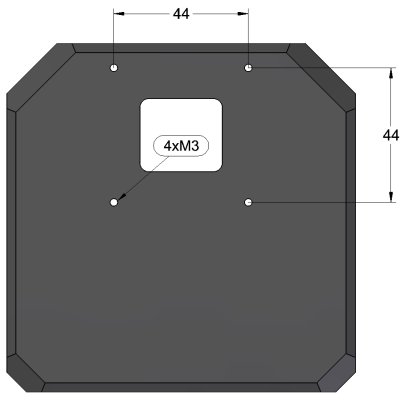
M3 threaded holes, used to mount the EFW, on the C2
camera head 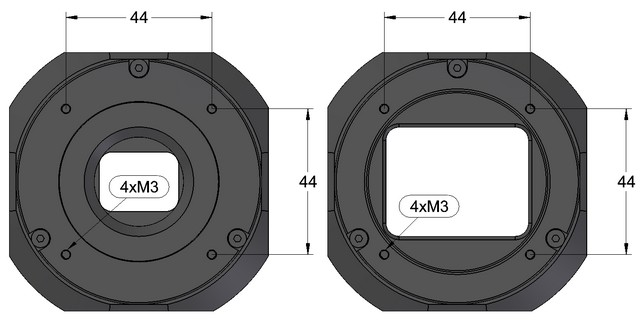
M3 threaded holes, used to mount the EFW, on the
C1+ and C1× camera
heads 
M3 threaded holes, used to mount the EFW, on the C3
camera head The „XS“ filter wheels
The „XS“ filter wheels are compatible
with C1+, C1×, and C2
cameras:
8 positions for unmounted filters
D31 mm or filters
in 1,25” threaded
cells. 7 positions for unmounted
D36 mm
filters.
The „S“ filter wheels
The „S“ filter wheels are compatible
with C1+, C1×, C2, and
C3 cameras:
12 positions for unmounted filters
D31 mm or filters
in 1,25” threaded
cells. 10 positions for unmounted
D36 mm
filters. 7 positions for unmounted
D50 mm or filters
in 2” threaded cells.. 5 positions for unmounted
50 × 50 mm filters.
EFW with „L“ (large) adapter base
The „L“-sized adapter base is intended for greater
adapters based on M68 × 1 thread,
offering more robust connection between the camera and
telescope. The Canon and Nikon lens bayonets are available
also with the „L“-sized adapter base.
The „M“ filter wheels
The „M“ filter wheels correspond to the
„S“-sized ones, only offer the „L“ adapter
base instead of the „S“ adapter base. So, these
filter wheels are compatible with the same camera series
C1+, C1×, C2, and C3
and accommodate the same filters:
12 positions for unmounted filters
D31 mm or filters
in 1,25” threaded
cells. 10 positions for unmounted
D36 mm
filters. 7 positions for unmounted
D50 mm or filters
in 2” threaded cells. 5 positions for unmounted
50 × 50 mm filters.
The „L“ filter wheels
The „L“ filter wheels are always
equipped with the „L“ adapter base. They
accommodate these filters:
Both „M“ and „L“ sized EFW are made
compatible with C2/C3 camera series as well as the C4 series,
designed for greater sensors. However, while the C4 cameras
also use four M3 threaded holes to attach EFW to camera head,
these holes are 52 mm apart,
compared to 44 mm of the C2/C3
series. Breaking the mechanical compatibility was necessary
because of the size of sensors, used in C4 line.
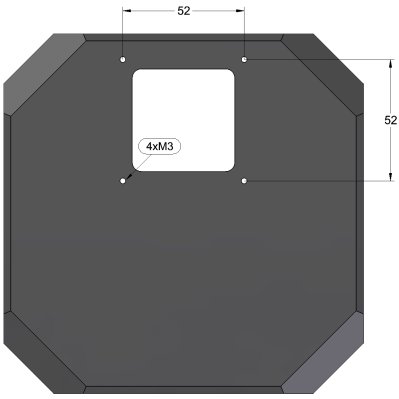
M3 threaded holes, used to mount the EFW, on the C4
camera head So, both „M“ and „L“ wheels are offered in -3
version, compatible with C2 and C3 cameras, and -4 version,
intended for C4 cameras.
EFW with „XL“ (extra-large) adapter base
The „XL“-sized adapter base is designed for the
M85 × 1 thread, used solely on C5
series cameras. Also, the Canon and Nikon lens bayonets are
available with „XL“-sized adapter base, but
photographic lenses always cause vignetting on very large C5
sensors.
The „XL“ filter wheels
The „XL“ filter wheels roughly equal to
the „L“-sized ones, only offer the „XL“
adapter base:
The „XL“ filter wheels use a pattern of six M3
threaded holes on the camera head, spaced by 60° around
the 70 mm diameter
circle:
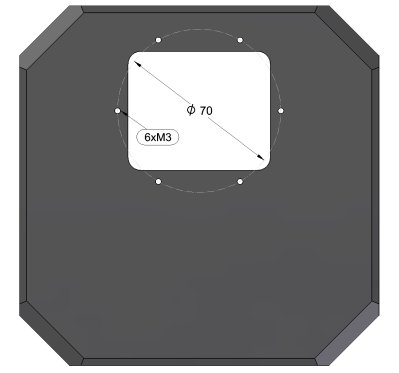
M3 threaded holes, used to mount the
„XL“ sized EFW, on the asymmetrical C5A camera
head The pattern is the same on both asymmetrical C5A and
symmetrical C5S camera versions.
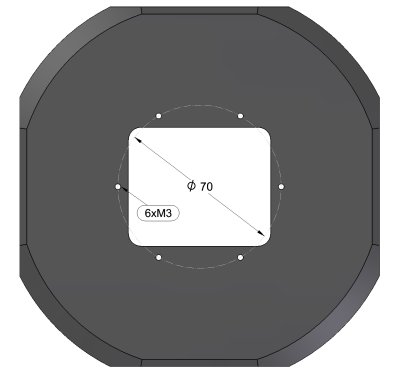
M3 threaded holes, used to mount the
„XL“ sized EFW, on the asymmetrical C5A camera
head Filter space
The space available for filters is the same, regardless of
the EFW size. However, comparing to internal filter wheels,
external filter wheels are thinner and thus also the space for
filters is narrower.
The difference between filter wheels designed for
both unmounted filters and filters in threaded cells, and
filter wheels intended only for unmounted filters, also
apply. This means the filters can be up to 1 mm thicker if the filter wheel is
designed for unmounted filters only.
The barrel portion of the filter threaded cells, used
in the external wheel, can be up to
5,5 mm thick.
The thread can be up to 3 mm
long. So, the total thickness of the cell can be up to
8,5 mm. Unmounted filters, but fixed in the wheel designed
also for threaded filter cells, can occupy up to
5,5 mm space.
Note such space includes not only the filter itself, but
also the fixing screw head and washer. As the head and
washer thickness typically slightly exceed 2 mm, it is safe to use up to
3,5 mm thick
unmounted filters . Filter wheels designed for unmounted filters only
(either D26 mm/1” or
D36 mm filters) can accommodate
up to 1 mm thicker
filters.
Installing or exchanging filters
Installing or exchanging filters requires opening of the
EFW shell. As there are no mechanical of electronics devices
inside the shell but the wheel motor drive, opening the EFW
shell and exchanging filters is easier compared to IFW.
Moravian Instruments filter wheels are always designed so
the aperture manufactured in the wheel, not the inserted
filter, faces the incoming light cone. So, the complex shapes
like unmounted filter edges, holding screws, etc., possibly
causing reflections, are always hidden from the incoming
light.
The geometry of the EFW requires to remove the filter wheel
from the shell to insert or replace filters. Otherwise, when
the filter wheel is removed, fixing of individual filter types
in the wheel remains the same like in the case of IFW.
External filter wheel vignetting
The External filter wheels allow usage of bigger filters,
but at the same time filter wheel input pupil is filter wheel
input pupil is 28.5 mm from the
sensor, further than in the case of internal wheels.
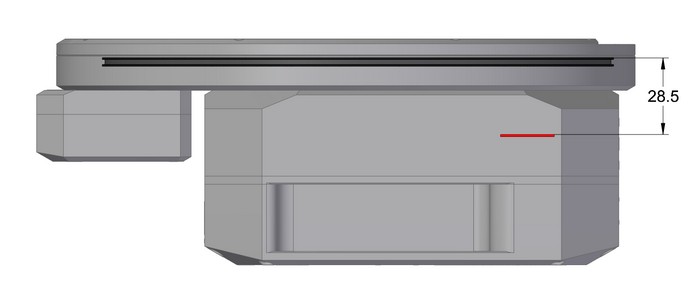
External filter wheel input pupil distance to
sensor C1+ and C2 cameras with External filter wheel
The smallest filters available in the external wheels
are mounted in 1.25” threaded cells. Typically, these
filters have 24 mm input pupil.
| Camera model |
Sensor diagonal |
Filter diameter |
Limiting f/ratio |
| C1+/C2-3000 |
8.89 mm |
24 mm |
1.89 |
| C1+/C2-5000 |
11.07 mm |
24 mm |
2.20 |
| C1+/C2-7000 |
17.56 mm |
24 mm |
4.42 |
| C1+/C2-9000 |
15.99 mm |
24 mm |
3.56 |
| C1+/C2-12000 |
17.58 mm |
24 mm |
4.44 |
| C1+/C2-46000 |
23.31 mm |
24 mm |
41.59 |
C2-46000 would suffer from vignetting with 1.25”
filters with virtually every telescope used.
When the unmounted D31 mm
with 27 mm input pupil are
used, vignetting starts to be less prominent.
| Camera model |
Sensor diagonal |
Filter diameter |
Limiting f/ratio |
| C1+/C2-3000 |
8.89 mm |
27 mm |
1.57 |
| C1+/C2-5000 |
11.07 mm |
27 mm |
1.79 |
| C1+/C2-7000 |
17.56 mm |
27 mm |
3.02 |
| C1+/C2-9000 |
15.99 mm |
27 mm |
2.59 |
| C1+/C2-12000 |
17.58 mm |
27 mm |
3.03 |
| C1+/C2-46000 |
23.31 mm |
27 mm |
7.73 |
The C2-46000 start to be usable with unmounted
D31 mm filters in the
external wheel from approx. f/8.
The external filter wheels for unmounted D36 mm filters with 34 mm aperture are no barrier for any C2
camera, including the C2-46000 model.
| Camera model |
Sensor diagonal |
Filter diameter |
Limiting f/ratio |
| C1+/C2-3000 |
8.89 mm |
34 mm |
1.14 |
| C1+/C2-5000 |
11.07 mm |
34 mm |
1.24 |
| C1+/C2-7000 |
17.56 mm |
34 mm |
1.73 |
| C1+/C2-9000 |
15.99 mm |
34 mm |
1.58 |
| C1+/C2-12000 |
17.58 mm |
34 mm |
1.74 |
| C1+/C2-46000 |
23.31 mm |
34 mm |
2.67 |
C1× and C3 cameras with
External filter wheel
An external filter wheels for unmounted D36 mm filters offer 34 mm input pupil, but further from the
sensor compared to Internal variant.
| Camera model |
Sensor diagonal |
Filter diameter |
Limiting f/ratio |
| C1×/C3-26000 |
28.27 mm |
34 mm |
4.97 |
| C1×/C3-61000 |
43.29 mm |
34 mm |
N/A |
The unmounted D36 mm
filters in the external wheel are suitable for the
C1×26000 and C3-26000
cameras only if combined with relatively slow optics. The
C1×61000 and C3-61000 cannot
be used with such small filters.
The external filter wheels for filters in 2” threaded
cells offer 44 mm input
pupil, but again the exact diameter depends on the
manufacturer.
| Camera model |
Sensor diagonal |
Filter diameter |
Limiting f/ratio |
| C1×/C3-26000 |
28.27 mm |
44 mm |
1.81 |
| C1×/C3-61000 |
43.29 mm |
44 mm |
39.92 |
The vignetting in the image corners is unavoidable with
2” filters and C1×/C3-61000
camera.
The unmounted D50 mm
filters in the wheel for 2” filters enlarge the input
pupil from 44 to 47 mm.
| Camera model |
Sensor diagonal |
Filter diameter |
Limiting f/ratio |
| C1×/C3-26000 |
28.27 mm |
47 mm |
1.52 |
| C1×/C3-61000 |
43.29 mm |
47 mm |
7.67 |
Usage of the unmounted D50 mm filters with the C1×/C3-61000 camera
results into vignetting with all but quite slow
telescopes.
Almost unavoidable vignetting of the C1×/C3-61000 camera combined with round
filters, regardless if in 2” threaded cells or unmounted
D50 mm, often causes users
opt for square 50 × 50 mm
filters.
| Camera model |
Sensor long side |
Filter side |
Limiting f/ratio |
| C1×/C3-26000 |
23.51 mm |
48 mm |
1.16 |
| C1×/C3-61000 |
36.01 mm |
48 mm |
2.38 |
The square 50 × 50 mm
filters allow usage of the C1×/C3-61000 camera without vignetting
with virtually any telescope.
C4 cameras with External filter wheel
Only the square 50 × 50 mm
filters in the external filter wheel are offered with the
C4 cameras.
| Camera model |
Sensor side |
Filter side |
Limiting f/ratio |
| C4-16000 |
36.86 mm |
48 mm |
2.56 |
These filters place no restrictions on using the
C4-16000 camera with virtually any telescope in terms of
vignetting.
C5 cameras with External filter wheel
A variant of the XL-size external filter wheel for
square 50 × 50 mm filters is available for the C5
cameras, both asymmetrical C5A and symmetrical C5S camera
variants.
| Camera model |
Sensor long side |
Filter side |
Limiting f/ratio |
| C5-100M |
43.86 mm |
48 mm |
6.88 |
| C5-150M |
53.42 mm |
48 mm |
N/A |
The square 50 × 50 mm
filters allow usage of the C1×/C3-61000 camera without vignetting
with virtually any telescope.
Another variant of the external filter wheel for the C5
cameras is intended for square 65 × 65 mm
filters.
| Camera model |
Sensor long side |
Filter side |
Limiting f/ratio |
| C5-100M |
43.86 mm |
63 mm |
1.49 |
| C5-150M |
53.42 mm |
63 mm |
2.97 |
The square 65 × 65 mm
filters can be used with the C5 cameras with any
telescope.
Standalone Filter Wheels
While the external filter wheels can accommodate more filters
compared to the internal ones, even the external filter wheel
diameter has construction limits. It is not possible to simply
increase both EFW shell and filter wheel itself. The diameter and
weight would be so big, that usage of such wheels would not be
practical.
Natural solution of this problem is placing of two smaller
filter wheels beside each other. The total number of filter
positions is lower than the sum of positions in both wheels from
obvious reasons: one position in each wheel must remain empty
(clear) and it is set as an actual position when a filter from the
other wheel is to be used not to interfere with it. So, if for
instance two filter wheels with five positions each are used, we
denote such wheel as 8+Clear positions. This means four positions
in both wheels may be used for any filter, which makes 8 total
filter positions. When both filter wheels are set to index 1 (the
clear position), one additional clear position is added to the
total number of filter positions.
The Moravian Instruments Standalone Filter Wheel (SFW)
comes in the „XXL“ flavor, which indicates it is even
greater than the larges „XL“ sized EFW available. Number
of available positions depends on filter size:
8+Clear positions for „65 × 65 mm“
square filters, suitable for C5 cameras (both asymmetrical C5A
and symmetrical C5S variants) 12+Clear positions for 50 × 50 mm
square filters, suitable for C5-100M cameras (with some
vignetting over the sensor short edge), but also for C4 and C3
cameras, also using 50 × 50 mm
filters 16+Clear positions for unmounted
D50 mm or filters in
2” threaded cells for C3 cameras.
While the SFW filter wheels are always equipped with
the „XL“ sized telescope interface, offering
M85 × 1 or M68 × 1 threaded adapter, as well as the Canon
EOS and Nikon lens adapters, the SFW back plate is manufactured
in three versions:
The -5 version with six holes for M3 screws for C5
cameras. The -4 version with four holes for M3 screws 52 mm apart for C4 cameras. The -3 version with four holes for M3 screws 44 mm apart for C3 cameras.
Power and control interface
As opposed to IFW and EFW, the SFW filter wheels need
separated power and control lines. The SFW control unit is
equipped with 12 V DC
5,5/2,5 mm power plug as well as USB 1.1 data connection.
The SFW control can be also handled by the Moravian Camera
Ethernet Adapter together with a main imaging, guiding, and
context cameras. Only make sure the Moravian Camera Ethernet
Adapter device is updated with the latest firmware
available.
Back focal distance
While all EFWs from „XS“ to „XL“ size are
designed to preserve the very same BFD on all Cx cameras, the
SFW naturally increased the BFD because of the design using
two overlapping wheels. The resulting BFD depends on the
adapter used.

The C5A camera with SFW and M85 × 1 adapter offers 54.5 mm BFD 
The C5A camera with SFW and M68 × 1 v2 adapter offers 52 mm BFD 
The C5S camera with SFW and M85 × 1 adapter offers 54.5 mm BFD 
The C5S camera with SFW and M68 × 1 v2 adapter offers 52 mm BFD Filter space
The space for filters in the SFW corresponds to the
space available in EFW wheels.
The barrel portion of the filter threaded cells, used
in the standalone wheel, can be up to 5 mm thick. This is
0,5 mm less
compared to EFW; the reason is up to 1 mm space of the threaded part of filters
in the second wheel. The thread can be up to 3 mm long. So, the total thickness of the
cell can be up to 8 mm. Unmounted filters, but fixed in the wheel designed
also for threaded filter cells, can occupy up to
5,5 mm space.
Note such space includes not only the filter itself, but
also the fixing screw head and washer. As the head and
washer thickness typically slightly exceed 2 mm, it is safe to use up to
3,5 mm thick
unmounted filters. Filter wheels designed for unmounted filters only
(either square 50 × 50 or
65 × 65 mm filters) can accommodate up to
1 mm thicker
filters.
Filter positions
Distinguishing to which position should be each wheel
rotated is handled by the filter wheel driver and from the
user's perspective such wheel acts as one wheel with 9
positions, filters are indexed from 1 to 9.
It is necessary to open the SFW front shell prior to
installing filters. There are two filter wheels inside, one is
on top (closer to the telescope), another is on the bottom of
the shell.

Top and Bottom filter wheels in the SFW
shell 8+Clear filter wheel
| Final position |
Filter wheel |
Wheel position |
| 1 (clear) |
Bottom/Top |
1 |
| 2 |
Bottom |
2 |
| 3 |
Bottom |
3 |
| 4 |
Bottom |
4 |
| 5 |
Bottom |
5 |
| 6 |
Top |
2 |
| 7 |
Top |
3 |
| 8 |
Top |
4 |
| 9 |
Top |
5 |
12+Clear filter wheel
| Final position |
Filter wheel |
Wheel position |
| 1 (clear) |
Bottom/Top |
1 |
| 2 |
Bottom |
2 |
| 3 |
Bottom |
3 |
| 4 |
Bottom |
4 |
| 5 |
Bottom |
5 |
| 6 |
Bottom |
6 |
| 7 |
Bottom |
7 |
| 8 |
Top |
2 |
| 9 |
Top |
3 |
| 10 |
Top |
4 |
| 11 |
Top |
5 |
| 12 |
Top |
6 |
| 13 |
Top |
7 |
16+Clear filter wheel
| Final position |
Filter wheel |
Wheel position |
| 1 (clear) |
Bottom/Top |
1 |
| 2 |
Bottom |
2 |
| 3 |
Bottom |
3 |
| 4 |
Bottom |
4 |
| 5 |
Bottom |
5 |
| 6 |
Bottom |
6 |
| 7 |
Bottom |
7 |
| 8 |
Bottom |
8 |
| 9 |
Bottom |
9 |
| 10 |
Top |
2 |
| 11 |
Top |
3 |
| 12 |
Top |
4 |
| 13 |
Top |
5 |
| 14 |
Top |
6 |
| 15 |
Top |
7 |
| 16 |
Top |
8 |
| 17 |
Top |
9 |
Standalone filter wheel vignetting
The Standalone filter wheels contain two wheels, one above
another. The „bottom“ wheel (closer to the camera)
keeps the same distance 28.5 mm
from the sensors like the External filter wheels. But the
input pupils of both wheels are the same and thus only the
„top“ wheel (closer to the telescope) affects
vignetting and the distance 37.5 mm between input pupil and sensor must be
counted. So, SFWs cause greater vignetting compared to
EFWs.

Standalone filter wheel input pupil distance to
sensor C1× and C3 cameras with
Standalone filter wheel
A standalone filter wheel for unmounted D50 mm filters offer 47 mm input pupil, but further from the
sensor compared to the External variant.
| Camera model |
Sensor diagonal |
Filter diameter |
Limiting f/ratio |
| C1×/C3-26000 |
28.27 mm |
47 mm |
2.00 |
| C1×/C3-61000 |
43.29 mm |
47 mm |
10.10 |
The unmounted D50 mm
filters in the standalone wheel are suitable for the
C1×26000 and C3-26000
cameras, but usage with C1×61000 and C3-61000 will always lead to
some vignetting in the image corners.
The square 50 × 50 mm
filters are more suitable for the usage in the SFW.
| Camera model |
Sensor long side |
Filter side |
Limiting f/ratio |
| C1×/C3-26000 |
23.51 mm |
48 mm |
1.53 |
| C1×/C3-61000 |
36.01 mm |
48 mm |
3.13 |
These filters do not impose limitations for the
C1×/C3-61000 camera with SFW
with virtually any telescope.
C4 cameras with Standalone filter wheel
Only the square 50 × 50 mm
filters in the standalone filter wheel are offered with C4
cameras.
| Camera model |
Sensor side |
Filter side |
Limiting f/ratio |
| C4-16000 |
36.86 mm |
48 mm |
3.37 |
Even with SFW, the 50 × 50
mm square filters do not cause vignetting even with quite
fast telescopes.
C5 cameras with Standalone filter wheel
A variant of the standalone filter wheel for square
50 × 50 mm filters can be used with C5 cameras,
both asymmetrical C5A and symmetrical C5S.
| Camera model |
Sensor long side |
Filter side |
Limiting f/ratio |
| C5-100M |
43.86 mm |
48 mm |
9.06 |
| C5-150M |
53.42 mm |
48 mm |
N/A |
However, the square 50 × 50 mm
filters in the SFW cause vignetting along the sensor
shorter edge even with the C5-100M camera.
The square 65 × 65 mm
filters offer much wider input aperture 63 mm.
| Camera model |
Sensor long side |
Filter side |
Limiting f/ratio |
| C5-100M |
43.86 mm |
63 mm |
1.96 |
| C5-150M |
53.42 mm |
63 mm |
3.91 |
These filters do not limit usage with any C5 camera
combined with SFW.
| 